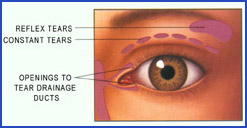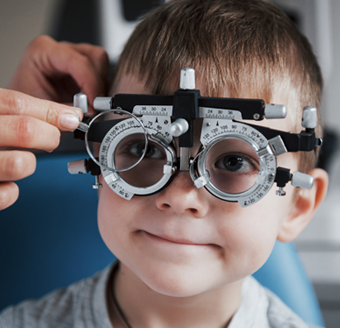 Your eyes are lubricated by two different types of tears that are produced by glands in your upper and lower lids. The main type of tear is referred to as a constant tear. Constant tears are composed of water, oil and mucin layers and are continuously produced to provide lubrication and to fight infections of the eye. The other type of tear is called a reflex tear; it is a watery tear that is produced when the eye is irritated (wind, bright lights, etc.) or when you cry. The reflex tears simply rinse the surface of the eye and do not provide significant lubrication.
Your eyes are lubricated by two different types of tears that are produced by glands in your upper and lower lids. The main type of tear is referred to as a constant tear. Constant tears are composed of water, oil and mucin layers and are continuously produced to provide lubrication and to fight infections of the eye. The other type of tear is called a reflex tear; it is a watery tear that is produced when the eye is irritated (wind, bright lights, etc.) or when you cry. The reflex tears simply rinse the surface of the eye and do not provide significant lubrication.
Dry Eye Syndrome is a disorder of the tear film due to an imbalance of one of the three components of the tear film (water, oil and mucous) or to excessive evaporation of the tear film which leads to damage to the surface of the eye and an overall uncomfortable feeling eye.
Five common causes of Dry Eye Syndrome:
 Contact Lenses - Contacts lenses can dramatically increase tear evaporation causing irritation and discomfort to the eye and leading to increased calcium and protein deposits and oily film build up on your lenses. Research has shown that dry eye is the leading cause of contact lens discomfort and "drop out".
Contact Lenses - Contacts lenses can dramatically increase tear evaporation causing irritation and discomfort to the eye and leading to increased calcium and protein deposits and oily film build up on your lenses. Research has shown that dry eye is the leading cause of contact lens discomfort and "drop out".- Age - Tear production decreases with age by as much as 60%. This decrease in the constant tears can cause the eye to feel irritated which often leads to an increase in reflex tears. (eyes that constantly water!)
- Environment - Arid climates, high altitudes and windy conditions increase tear evaporation. The use of ceiling fans, heaters, air conditioners, and computer fans all contribute to dry eyes.
- Medications - Many medications, both prescription and over the counter decrease the body’s ability to produce constant tears. Examples include decongestants, antihistamines, heart disease and high blood pressure medications, antidepressants, and Beta-Blockers.
- Hormone changes - In many women, as the body’s estrogen level decreases throughout life and into menopause, the body’s lubricating system changes. Most women suffer from dry mouth and dry eyes at some point in their life.
Do you suffer from Dry Eye Syndrome?
Take our "Dry Eye Quiz". The results will be reviewed by the doctors and, if indicated, a consultation can be scheduled to determine if you could benefit from the currently available dry eye treatments.
Can Dry Eye Syndrome be treated?
There is no cure for dry eyes, but with treatment, it can be managed. Treatment may include one or more of the following:
- Artificial tears and ointments
- Warm compresses with a warm, wet terrycloth or heated mask
- Punctal plugs, either temporary or permanent
- Increased water intake if dehydrated
- Supplements containing Omega-3 fatty acids
- Environmental modifications, i.e. humidifiers, aiming air vents away from face
- Prescription topical drugs, i.e. Restasis, Xiidra
- Laser occlusion of puncta
- Changes in diet, i.e. oily fish like salmon or tuna, walnuts, flax seed
- Taking hourly short breaks from near tasks, like computer work, cellphone use, reading
At the time of your exam, please feel free to speak with your doctor about symptoms you are having. After evaluating your eyes, the doctor will recommend appropriate treatment options for your eyes.



